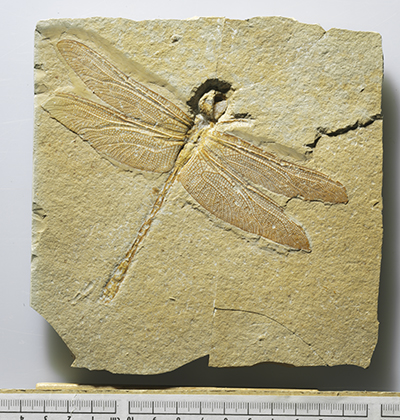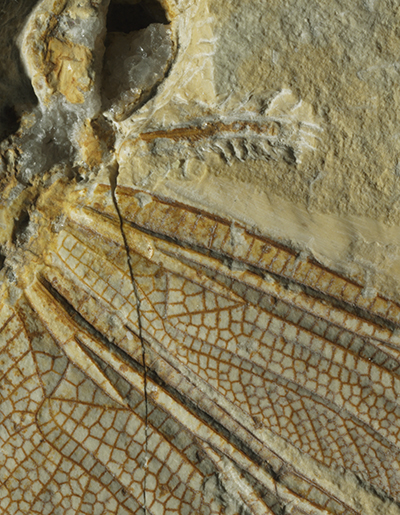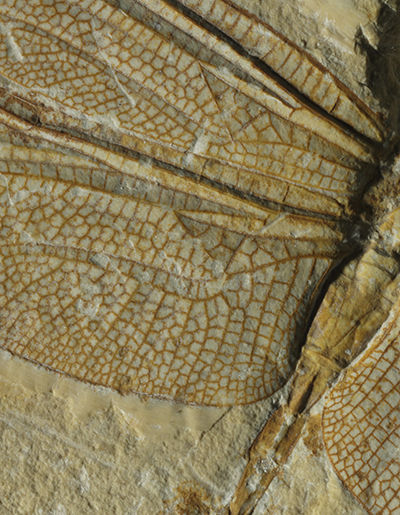January 2024: Dragon fly
Dragon fly (Odonata) Cymatophlebia longialata (Münster in Germar, 1839),
Late Jurassic, ca. 150 million years, „Solnhofen platy limestones”, Eichstätt, Oberbayern
Findings of fossil insects, except for amber, are rare in comparison to fossil remains of animals characterized by hardparts like shells or skeletons. However, there are quite a few localities with preserved fossil insects through earth history: from their first appearance 400 mio. years ago in the Devonian, to the giant forms in the Carboniferous (“Steinkohlenzeitalter”) and numerous localities in the Palaeozoic and Mesozoic to the Neogene including also occurrences in Germany. Especially the Upper Jurassic “Solnhofen platy limestones” of the Franconian Alb in Bavaria are of invaluable worldwide importance for phylogenetical research on insects. The most important and high-yield localities are outcrops in the area of Eichstätt, further but low-yield localities are situated in the area of Solnhofen.
Beyond a doubt dragon flies are the most beautiful fossil insects in the “Solnhofen platy limestones”. Here, they appear in an extraordinary diversity with to date about 50 different species. That makes Solnhofen – together with the cretaceous Crato-Formation of Brazil – to the most diverse locality worldwide.
Dragon flies are characterized by two pairs of similar wings originating from a thick thoracic section. The wings show a highly specialized venation. The abdomen is slim and elongated, it acts as a balancing pole. The compound eyes at the highly flexible head are extremely well developed, whereas the antennae are always short. These characteristics empower the predatory dragon flies to a well coordinated and fast flight.
The “Solnhofen platy limestones” originated 150 mio. years ago as extremely fine laminated to fine bedded carbonate muds in lagoonal-like (“Wannen”) depressions within a coral and sponge reef archipelago at the northern margin of the Tethys ocean. The great abundance and diversity of dragon flies are related to their very good flying capabilities and flying activity. Therefore, dragon flies were capable of reaching depositional areas in larger distance off the coastline than other insects.
The very well preserved specimen, exhibited here, stems from the historical collection of Karl Friedrich Häberlein, country doctor from Pappenheim. Together with his son, Ernst Otto, the Häberleins owned the most precious and by far largest private collection of platy limestone fossils in the 19th century. Due to the build-up and the transfer, especially to scientific institutions, the Häberleins render great service to palaeontology. An important part of the collection of Karl F. Häberlein, including the dragon fly displayed here, was purchased by the Bavarian King Maximilian II. Josef in 1856 for 11.000 Gulden and then transferred to the Bavarian State Collection in Munich.



Martin Nose & Carolin Hoffmann,
beide München



